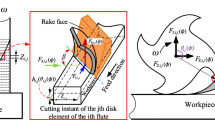A comprehensive, 3D mathematical model of desired/optimal cutting force for end milling of freeform surfaces is proposed in this paper. A closed-form predictive model is developed, based on a perceptive cutting approach, resulting in a cutting force model having a comprehensive set of essential cutting parameters. In particular, the normal rake angle, usually missing in most existing models of the same sort, is included in the developed model. The model also permits quantitative analyses of the effect of any parameters on the cutting performance of the tool, providing a guideline to improving the tool performance. Since the axial depth of cut varies with time when milling sculptured surface parts, an innovative axial depth of cut estimation scheme is proposed for the generation of 3D cutting forces. This estimation scheme improves on the practicality of most existing predictive cutting-force models for milling, in which the major attention has been focused on planar milling surface generation. In addition, the proposed model takes the rake surface on the flute of mills as an osculating plane to yield 3D cutting force expressions in only two steps. This approach greatly reduces the time-consuming mathematical work normally required for obtaining the cutting-force expressions. A series of milling simulations for machining freeform parts under specific cutting conditions have been performed to verify the effectiveness of the proposed cutting-force model. The simulation results demonstrate the accurate estimating capability of the proposed method for axial depth of cut estimation. The cutting force responses from the simulation exhibit the same trends as can be obtained using the empirical mechanic’s model referenced in the literature. Finally, from the simulation results it is also shown that designing a tool with a combination of different helix angles, having cutting force signatures similar to those of the single helix angle counterparts, is particularly advantageous.
Similar content being viewed by others
Author information
Authors and Affiliations
Rights and permissions
About this article
Cite this article
Lee, T., Lin, Y. A 3D Predictive Cutting-Force Model for End Milling of Parts Having Sculptured Surfaces. Int J Adv Manuf Technol 16, 773–783 (2000). https://doi.org/10.1007/s001700070011
Issue Date:
DOI: https://doi.org/10.1007/s001700070011




